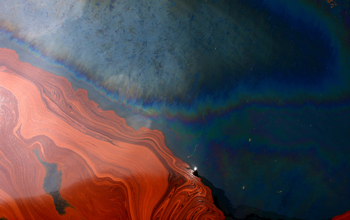Multimedia Gallery
Thick layer of oil atop the Gulf of Mexico following Deepwater Horizon oil spill
A thick layer of weathered oil from the Deepwater Horizon oil spill blowout floats atop the Gulf of Mexico.
More about this image
A team of researchers, led by David Valentine of the University of California, Santa Barbara, and John Kessler of Texas A&M university, embarked on a research cruise with the mission of determining the fate and impact of hydrocarbon gases that were escaping from the deep-water oil spill. The disaster provided a rare opportunity to study the behavior of methane and other natural gases in deep water. Experiments by the team were conducted as close as 1,500 feet from the epicenter of the active spill. Underwater sampling devices and sensors were used to measure hydrocarbons and oxygen depletion at various depths, and to collect water samples to study the biodegradation of natural gas and the associated blooms of bacteria.
[Research supported by the U.S. National Science Foundation (grants OCE 1042097, OCE 0961725 and OCE 1042650) and the U.S. Department of Energy.]
Learn more about the research in the Nature story Oil-spill Bacteria Gobbled Gases First. (Date of Image: June 2010; date added to Multimedia Gallery: Feb. 1, 2013)
Credit: David L. Valentine, University of California, Santa Barbara
See other images like this on your iPhone or iPad download NSF Science Zone on the Apple App Store.
Images and other media in the National Science Foundation Multimedia Gallery are available for use in print and electronic material by NSF employees, members of the media, university staff, teachers and the general public. All media in the gallery are intended for personal, educational and nonprofit/non-commercial use only.
Images credited to the National Science Foundation, a federal agency, are in the public domain. The images were created by employees of the United States Government as part of their official duties or prepared by contractors as "works for hire" for NSF. You may freely use NSF-credited images and, at your discretion, credit NSF with a "Courtesy: National Science Foundation" notation.
Additional information about general usage can be found in Conditions.
Also Available:
Download the high-resolution JPG version of the image. (3.5 MB)
Use your mouse to right-click (Mac users may need to Ctrl-click) the link above and choose the option that will save the file or target to your computer.

 All images in this series
All images in this series